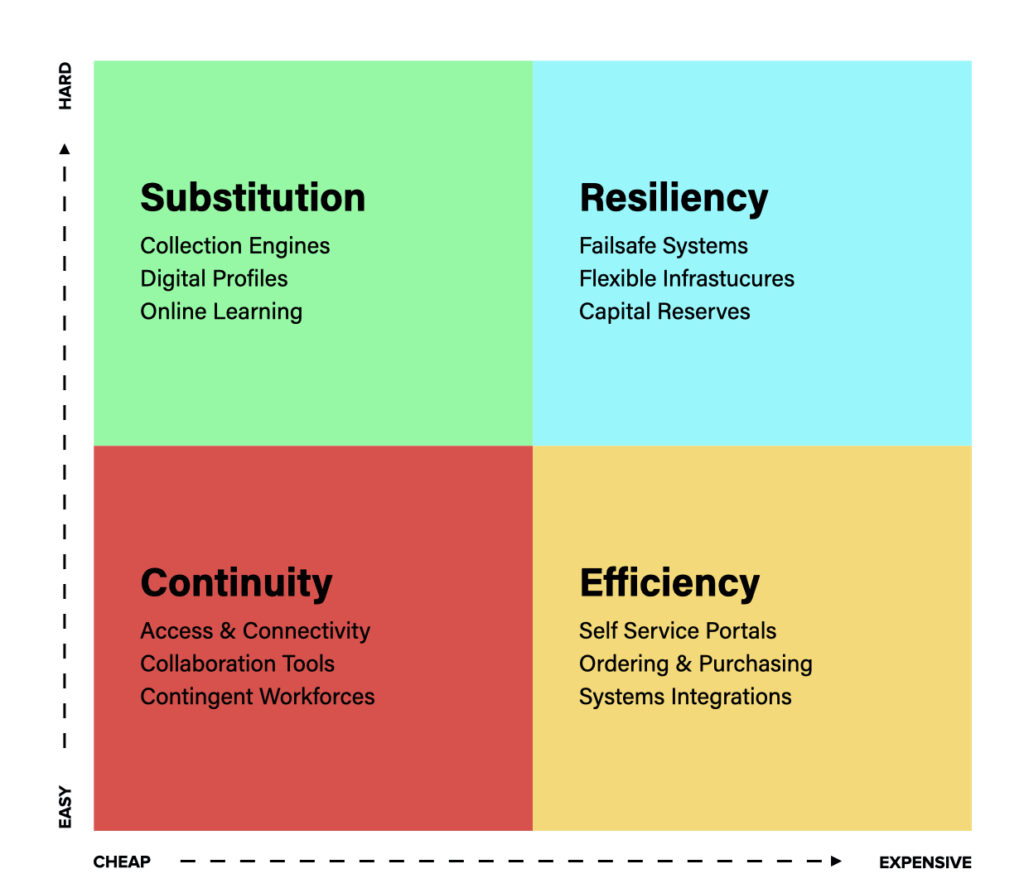Introduction
The COVID-19 crisis has put into stark contrast just how fragile and interdependent our world really is. Companies and organizations have embraced the latest slew of digital tools as a necessity, all in an act for normalcy, continuity and survival. Nearly overnight, this brutish attempt at survivalism has pushed our professional workforce to perform in an uncomfortable virtual setting, forcing most of us who have not been indoctrinated into the ways of digital to improvise.
In an attempt to make sense of our current chaotic environment, leveraging the flexible 2×2 Decision Matrix makes the most sense. Typically, strategy experts use this framework at the start of a planning cycle or to assist in making tough decisions about business focus. I’ve chosen this structured approach to help frame the latter and by identifying four current key trends and measuring them across two essential business dimensions: effort and cost. I start with what is happening now, namely the need for continuity and move into more challenging, yet required territories, in the form of resiliency.
Pre-pandemic, we had the time to pontificate about ideal virtual collaboration tools, methods, or balanced work from home policies, but all that feels very distant now. The need for serious revenue generation and organizational continuity has taken command to usher many of us (privileged knowledge workers) into the next normal.
How will this new reality impact the business climate within the next 24-36 months? No one wants to be the ones shuffling chairs on the Titanic. Navigating through these uncertain times requires an understanding of the deeper trends that are already happening in business and will more than likely materialize into our digital ecosystem. Your organization’s survival in this future ecosystem will depend on four key elements: Continuity, Efficiency, Substitution and Resiliency.

Digital Ecosystem Matrix
Continuity
Let’s start with the basics. It’s obvious that nothing happens without an Internet access connection. Thankfully, only 6 percent of the U.S. population lacks access to broadband services (at threshold speeds). We’ve been incredibly lucky to have this vital edge utility at our disposal (from both home and work). With the recent rollout of 5G, Internet access will allow us to always be on. Furthermore, increased speeds, decreased sensor costs and greater connectivity to web-enabled devices will guarantee that our production (both actively and passively) won’t fall into decline.
This always-on mentality is already reducing friction and training knowledge workers to do more with online collaboration tools. We’ve seen mass adoptions to Zoom (or Slack, Basecamp, Microsoft Teams, etc.) because it does a fairly good job of substituting our daily rituals for group meetings and communications. But what’s really fascinating about these connected digital agents is their ability to pull more people into discussions, engage sub-subgroups via breakout “rooms” and record moments in time for better recall (and posterity). We will effectively teleport ourselves throughout the organization, where our skills — not our presence — will be most needed.
Companies that are succeeding have already organized themselves around their customers, where value gets generated based on what the customer needs to get done (skills), instead of optimizing organizational effectiveness (processes and politics). As more unique customer needs continue to surface, organizations will inevitably require a more nimble, flexible and competent support system. Powered by a contingent workforce (i.e. contractors and freelancers), companies will continue to fill in the skills gap and tap into a deeper set of experts, affordably and on an as-needed basis.
Efficiency
Pre-Pandemic, self service portals, ordering and purchasing and systems integrations were typically blocking and tackling moves that organizations would make. Surprisingly, it took an incredible amount of convincing to get outdated organizations to this point. Concerns over capital expenditure costs, optics around automation and diminishing KYC measures usually derail many of these initiatives. In our next normal, expect to see self-service functions via digital tools being essential instead of nice to have.
Data portability and accessibility will be essential to driving efficiency plays. Allowing customers to transact on their terms will become more and more commonplace. Traditional account managers and sales professionals will need to adapt to more virtual tools (i.e., video conferencing) to stay in touch with customers.
As time goes on, there will be less access to the customer, as social distancing and remote working continue to take root. Moreover, employers will reduce their reliance on commercial office space, as they have rightfully recognized that operations can continue, and that productivity will not suffer simply because you can’t “see” people working. A Gartner survey of 317 chief financial officers and finance leaders showed that roughly 3 in 4 intend to “move at least 5% of their previously on-site workforce to permanently remote positions post-COVID 19.” This is just the first wave. As more organizations seek to cut operational costs and reach larger pools of talent, there will be a collective realization that remote working has more benefits than challenges.
Substitution
As we get deeper into difficult times, organizations will need to push harder to add value, all while keeping costs as low as possible. The proverbial “do more with less” will mean the difference between those who survive and those who thrive in this next normal. Global companies whose revenues have taken a hit during the coronavirus pandemic plan to cut technology spending this year by as much as 4.1%, according to the latest survey from US-based Enterprise Technology Research (ETR). To that end, smaller organizations can use this time wisely to create digital agents that will accommodate their future digital customers. A major force that will accelerate this need is with the creation of bots to analyze user interactions and personalize experiences that keep them engaged (and from defecting). KYC will expand beyond the four walls of a given organization, as users are living more and more online, and their whole identities (personality traits, traceable habits and opinions) will become more evident.
Beyond KYC, tracking worker productivity in this new fashion will lead to new-found improvements. Think about the massive amounts of metadata that can be collected (and inferred) from login, location, duration, intensity and output. Granted, this can be tracked offline, but what can’t be easily tracked is the contents of actual work produced. Tracking from a productivity perspective does not stop there. Think of the endless meetings that are now being cut short or circumvented entirely as a result of time limitations placed upon the physical world. Although there is no better substitution for face-to-face meetings, video conferencing has unlocked the ability to see our teams (and collaborate with them on a deeper level) with the added bonus of time-shifting.
What does this increased use of digital mean in the long run? As more workers conduct their work virtually, they will no longer need to explicitly tell us about themselves (or their performance for that matter). Digital agents, tools and algorithms will become more sophisticated and analyze a given worker’s complete digital profile. They will come to not only analyze, but know who we are, what we are good at and when we are most available to be utilized – all from the invisible breadcrumbs that we will unconsciously leave behind.
As we continue to migrate our digital selves online, integrated systems and tools will continue to evolve and evaluate us. How we learn (and are scored) will also evolve from rote memorization to project-based learning. The ability to be tracked digitally will require us to demonstrate our expertise so that we’re not relying solely on reputation; rather, we will treat our current behaviors and past experiences as quantifiable signals of trust. Our tracks in the sand will remain and be treated as raw material for smarter algorithms to make sense of and communicate on our behalf.
Resiliency
In this next normal, a strong digital ecosystem will require higher levels of resiliency. This will result in a higher cost to most organizations as it will certainly require a higher degree of coordination with its employees, vendors and internal stakeholders. In light of what we’ve witnessed, developing fail safes and redundancies to ensure operational continuity will be a smaller price to pay than the alternative. Technology infrastructure will be even more important as offices will continue to rely on technology as the primary driver for all internal communications. This will require IT departments to rethink how tools, software and firewalls are set up. Allowing for more flexibility through strict corporate firewalls will be a welcome change for most corporate workers, so that they can get their work done. Online collaboration tools like Zoom, Asana and Mural will amplify the deficiencies that physical tools woefully possess, namely, the inability to access historical knowledge, quickly sort and organize, and analyze meaningful work outputs outside an organization’s four walls.
Apart from tools, redundancies in actual work streams will become more commonplace, as well as ensuring there are backups not only for our software, but for our people. Serious alternatives to current work plans should be factored into our work, should we face outages or losses to production.
Lastly, healthy capital reserves and dependable budgets must be in place in order for organizations to flourish. According to a recent report by JPMorgan Chase Institute, half of small businesses only have a large enough cash buffer to allow them to stay in business for 27 days, if they stop bringing in money. The bank calculated cash buffer days by computing the ratio of how much money a business had at the end of the day on average to its average daily outflows. Most companies ran out of buffer days within a month. Unbelievable as it sounds, the days of ultra lean cash flow to operate successfully will be a thing of the past. Organizations will factor in the additional cost for resiliency instead of chasing efficiency.
What’s Next?
COVID-19 is changing how we are interacting and transacting with others. In summary, the best proxy we have to maintain a sense of normalcy at the moment is digital. Its promise is to not only preserve our way of life but also serve as the vehicle for continuous improvement. Moving more towards a digital mindset and embracing these new methods and tools now will only strengthen your organization’s position in the long run. Software will eat the world — it is inevitable.
I’m reminded of a quote from the venerable Tony Robbins that sums up our collective predicament. “Change is inevitable. Progress is optional.” Change happens whether we like it or not. If one were to simply stand outside and wait a few minutes, as minuscule as it may seem, we’re bound to witness some form of change unraveling. It is automatic. Progress, on the other hand, requires intention and effort. What will make the difference between success or failure is how we respond to the challenges that are thrust upon us.
I hope this article has helped frame how your organization can potentially tackle these new challenges and address what needs to be done in the near term. In the event that you need a trusted advisor to dive a bit deeper into your particulars or craft strategies that are longer term, I would welcome the opportunity for us to collaborate.
Please feel free to contact me to arrange a time to explore options and ideas that will yield better outcomes for your organization. I’m here to help and serve you in the best way that I can.

